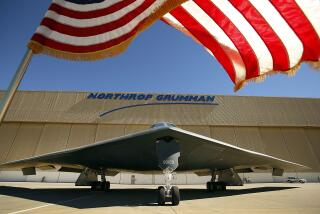Anticipated U.S. Cutbacks to Cost 6,000 Hughes Jobs
- Share via
Hughes Aircraft will eliminate 6,000 jobs over the next six months in response to anticipated federal defense spending reductions and in an effort to improve its competitiveness, the Los Angeles aerospace firm announced Wednesday.
Most of the cutbacks will occur in Southern California, where 84% of Hughes’ 75,000 workers are located. Although the exact burden of cuts has not been apportioned among the dozens of Hughes facilities, some operations facing difficult market conditions are likely to bear the brunt of the reductions, including the company’s industrial electronics, airborne radar and optical sensor businesses.
Hughes President Donald H. White said in an interview that the company expects most of the 6,000 job cuts to be accomplished through normal job turnover and early retirement but that involuntary layoffs will be necessary in some cases. Attrition accounts for as many as 7,500 job vacancies at Hughes each year, he said.
The Hughes cuts are the latest signal that federal defense budget reductions are likely to have broad impact across the industry and especially in Southern California. Only last week, Northrop announced a plan to cut 3,000 workers, and similar layoffs have occurred recently at Lockheed, General Dynamics, Litton Industries and TRW, among others.
Although the cutbacks so far have not been as drastic as in past aerospace downturns, they appear to be only the beginning of a protracted and painful slowdown that will continue at least through the mid-1990s. The slump should be moderated, however, by continued strength in commercial aircraft production.
Hughes has already been cutting back employment in recent years in an effort to cut costs. Employment peaked at more than 80,000 in 1985, even though the company has increased its sales since then.
“We have two things going on at once,” White said. “In some areas we have downsizing going on, because the amount of business is dropping off some. And everywhere, we have some streamlining, which is going to result in some reductions. And that’s to improve our competitiveness.”
White added: “As there is less business around, there are going to be tougher fights for it. And so we really have got to be very, very competitive to win it. That is what we have been working on for some time, and now we are accelerating.”
Hughes will attempt to moderate the effect of the job cuts on employees with a special incentive retirement program, according to employees interviewed by The Times. That program offers employees one week of pay for each year of service or a monthly annuity plan that would allow workers to retire up to three years early.
White said the cutbacks will affect all types of employees, including hourly production workers, engineers, managers and clerical workers. Since 75% of Hughes workers are salaried, numerically the cuts will be heaviest there.
“We want to cut our middle management bulge,” one missile engineer who requested anonymity said Wednesday after attending a company briefing about the job cutbacks. “I’ve been saying for years that we have too many middle managers.”
The Hughes job losses are not the direct result of any specific funding cuts by the Pentagon, White said, but are being made in expectation that proposed cutbacks will eventually occur. Defense Secretary Dick Cheney has proposed major program reductions that would affect Hughes, but those cuts await congressional approval and would not be felt for several years.
$1.5 Billion Involved
In an interview early this month, Hughes Chairman Malcolm R. Currie said the Cheney cuts for the fiscal 1990 budget would affect $1.5 billion worth of Hughes business. While not all of that represents lost business, a large amount of it has been thrown into uncertainty.
“Some of them (weapons programs) are stretched out, some of them are reduced and some of them are being cut (totally),” he said. “It is going to hit us across the company, but not in a drastic way.”
Since Hughes’ $7.4 billion in 1988 sales was made up mostly of relatively small electronics programs, the budget cuts are having a broad effect across the company. One major concern, however, is the status of radar for the B-2 Stealth bomber program. Cheney proposes to stretch out the bomber program by at least one year, and that could result in a reduction of the 1,500-member work force Hughes has on that program, Currie said.
At the same time that it is responding to specific budget cuts, Hughes is seeking to reduce its overall costs, which it has long recognized as being too high.
Hughes enjoyed explosive growth in the early 1980s, based on a significant technological lead over its competitors. It won a series of major contracts, in which it became the dominant producer of airborne radar, missiles, commercial satellites and air defense systems.
But more recently, the Pentagon has sought to drive down costs by setting up competitions among contractors that have emphasized price rather than technology. And Hughes’ high costs have resulted in a decline in the rate at which it has won new contracts. In many cases, it is being outbid by competitors in businesses that it has monopolized for decades.
“We haven’t been winning the big contracts,” an engineer at the company said, asking that his name not be published. “It looks like all the big ones are going to other companies.”
Paul Nisbet, an aerospace analyst at Prudential-Bache Securities, said Hughes may be hit harder by work force reductions than other contractors.
“Certainly those companies (like Hughes) that are dependent on older contracts are going to find that their level of activity is declining,” he said. “That would include companies like General Dynamics with its F-16, M-1 tank and submarine programs. Hughes has a mixture, but they haven’t won any really big ones lately.”
Lawrence M. Harris, an analyst at the Bateman Eichler, Hill Richards stock brokerage, said Hughes has come under more pressure to produce profits since it was acquired by General Motors in 1985.
“The cost structure may be a little higher for historical reasons,” he said.
White said the company will probably cut its research and development spending, which amounted to $276 million in 1988. It will also cut its spending to develop bids and proposals for new contracts, a measure of the effort put into winning new contracts.
But he said the cuts would not sacrifice future growth for short-term profits.
More to Read
Inside the business of entertainment
The Wide Shot brings you news, analysis and insights on everything from streaming wars to production — and what it all means for the future.
You may occasionally receive promotional content from the Los Angeles Times.











